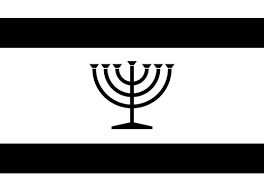What flag and what alphabet for a flagless, multi-alphabet language?
Medical Pharmaceutical Translations • Aug 3, 2015 12:00:00 AM

When language learning site Duolingo recently announced they’re developing Yiddish courses, many people were thrilled. But for some, the excitement was quickly dulled when the site decided to represent Yiddish with a flag showing a menorah framed by black bands.
This unofficial Yiddish flag has murky origins (and, somewhat paradoxically, a Facebook page). It was probably created around 2011 and was a go-to image for Duolingo users when considering how to visually identify Yiddish. But not all Yiddish speakers accept it. In an intriguing article, translator and Jewish scholar Sebastian Schulman explains the issue. For him, and doubtless for some others, the flag’s colors evoke mourning – not great, especially for what’s often called a dying language.
Worse still, the flag echoes that of Israel. This is a problem, Schulman explains, because for a long time, the Yiddish language faced discrimination and even a degree of suppression in Israel. There are other issues people might have with the flag, as well. For example, he writes, 20 th century leftist Yiddish speakers were against nationalism, and the Hasidic community, which represents an impressive portion of the world’s present-day Yiddish speakers, prefers to isolate itself from secular society and traditions like flags. And, Schulman adds, Yiddish speakers make up a virtual community as well, using the internet to communicate with each other across borders; language, not nationality, unites them.
Still, choosing a flag to represent Yiddish is understandable. On the internet, flags are shorthand for a language; if, say, you want the English-language version of a site, you look for the little UK or US flag symbol to click on. In fact, when I was researching another article for this blog, I found out that those little flags are regularly listed among the most essential features of a multilingual website.
But why not go with a relevant symbol (Schulman suggests a golden peacock) instead? It turns out this is a question that divides the community of another nationless tongue, Esperanto. In 1893, a flag was proposed for this made-up language, and many Esperanto speakers happily embraced it. But for others, the idea of a flag, implying a single nation, completely goes against Esperanto’s mission to be a global lingua franca. These people prefer the jubilee symbol — two green “E”’s facing each other on a white background. But this isn’t a solution; some speakers find the symbol useless, or even downright ridiculous.
The Duolingo Yiddish controversy has another twist to it. You might wonder, like I did, why not simply represent the language with the word “Yiddish” on a white background? But will the Yiddish on Duolingo be in Hebrew characters, or in the Roman alphabet? It can be, and often is, written in either. Duolingo has announced that it will be in Hebrew letters…in an official message whose two Yiddish phrases are written in both alphabets.
The situation is a complicated one, and there’s a lot at stake: Yiddish is widely considered an endangered language. Making it easy to identify and learn is crucial. Will the flag issue open a wound in the community? Will having to study the Hebrew alphabet on top of a foreign language turn away potential learners on Duolingo?
Hopefully, the online Yiddish community will be able to come to some kind of agreement about these issues, even if it means compromising and accepting the current proposed flag and Hebrew alphabet, at least for the time being. Duolingo says the Yiddish courses will be available in 2019, and they seem pretty determined to do things the way they’ve announced. But who knows what will happen in the years to come?
#translations #Duolingo #Yiddishlanguage #languageflags #aiatranslations
